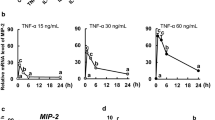Abstract
Objective The purpose was to investigate the expression of musashi-1 (msi-1) and its significances in small intestinal mucosa that was severely damaged by high-dose 5-FU. Methods A total of 40 adult C57BL/6J mice were divided into two groups: the control group (n = 8, group A) and experimental group (n = 32). The mice in the control group were treated with PBS by intraperitoneal injection, and the other mice were treated with high-dose 5-FU (150 mg/kg body weight for 5 consecutive days) by intraperitoneal injection. At the 1st (group B), 3rd (group C) and 5th (group D) day after treatment with high-dose 5-FU, the dying mice were killed, HE staining and immunohistochemical techniques were used to detect the expression of the putative marker of intestinal epithelial stem cells, msi-1, in samples of the middle intestine from these mice, and the percentage of the msi-1-positive cells from the intestinal mucosal cells of the mice in group B was detected by FACS. Results After treatment with high-dose 5-FU, the intestinal mucosa suffered severe damage: the villi and crypts disappeared, the number of msi-1-positive cells increased greatly, the intestinal epithelial cells could be divided into two fractions by FACS, and the percentage of msi-1-positive cells was up to 67.75% in the fraction in which the value of FSC was higher. Conclusions After treatment with high-dose 5-FU, the percentage of intestinal stem cells had increased significantly, which was useful for the further isolation and enrichment of intestinal epithelial stem cells.




Similar content being viewed by others
Reference
Booth C, Potten CS (2000) Gut instincts: thought on intestinal epithelial stem cells. J Clin Invest 105(11):1493–1499
Marshman E, Booth C, Potten CS (2002) The intestinal epithelial stem cell. Bioessays 24(1):91–98
Brittan M, Wright NA (2004) Stem cell in gastrointestinal structure and neoplastic development. Gut 53(6):899–910
Bjerknes M, Cheng H (2006) Intestinal epithelial stem cells and progenitors. Methods Enzymol 419:337–383
Nakamura M, Okano H, Blendy JA et al (1994) Musashi, a neural RNA-binding protein required for Drosophila adult eternal sensory organ development. Neuron 13:67–81
Potten CS, Booth C, Tudor GL et al (2003) Identification of putative intestinal stem cells and early lineage marker; musashi-1. Differentiation 71(28):28–41
Slorach EM, Campbell FC, Dorin JR (1999) A mouse model of intestinal stem cell function and regeneration. J Cell Sci 112(Pt 18):3029–3038
Potten CS, Owen G, Booth D (2002) Intestinal stem cells protect their genome by selective segregation of template DNA strands. J Cell Sci 115(Pt 11):2381–2388
Kim KA, Kakitani M, Zhao J et al (2005) Mitogenic influence of human R-spondin1 on the intestinal epitheliu. Science 309(5738):1256–1259
Ottewell PD, Duckwoth CA, Varro A et al (2006) Gastrin increases murine intestinal crypt regeneration following injury. Gastroenterology 130(4):1169–1180
Buning KD (2002) ABC transporters as phenotypic markers and functional regulators of stem cells. Stem Cells 20(1):11–20
Dekaney CM, Rodriguez JM, Graul MC et al (2005) Isolation and characterization of a putative intestinal stem cell fraction from mouse jejunum. Gastroenterology 129(5):1567–1580
Fukui T, Takeda H, Shu HJ et al (2006) Investigation of musashi-1 expressing cells in the murine model of dextran sodium sulfate-induced colitis. Dig Dis Sci 51(7):1260–1268
Van Zant G (1984) Studies of hematopoietic stem cells spared by 5-fluorouracil. J Exp Med 159(3):679–690
Zhou S, Schuetz JD, Bunting KD et al (2001) The ABC transporter Bcrp1/ABCG2 is expressed in a wide variety of stem cells and is a molecular determinant of the side-population phenotype. Nat Med 7(9):1028–1034
Uchida N, Dykstra B, Lyons K et al (2004) ABC transporter activities of murine hematopoietic stem cells vary according to their developmental and activation status. Blood 103(12):4487–4495
Challen GA, Little MH (2006) A side order of stem cells: the SP phenotype. Stem Cells 24(1):3–12
Lovell MA, Geiger H, Van Zant GE et al (2006) Isolation of neural precursor cells from Alzheimer’s disease and aged control postmortem brain. Neurobiol Aging 27(7):909–917
Okano H, Kawahara H, Toriya M et al (2005) Function of RNA-binding protein musashi-1 in stem cells. Exp Cell Res 306(2):349–356
Potten CS, Boot C, Tudor GL et al (2003) Identification of a putative intestinal stem cell and early lineage marker; musashi-1. Differentiation 71(1):28–41
Asai R, Okano H, Yasugi S (2005) Correlation between musashi-1 and c-hairy-1 expression and cell proliferation activity in the developing intestine and stomach of both chicken and mouse. Dev Growth Differ 47(9):501–510
Crosnier C, Stamataki D, Lewis J (2006) Organizing cell renewal in the intestine: stem cells, signals and combinatorial control. Nat Rev Genet 7(5):349–359
Kayahara T, Sawada M, Takaishi S et al (2003) Candidate markers for stem and early progenitor cells, musashi-1 and Hes1, are expressed in crypt base columnar cells of mouse small intestine. FEBS Lett 535(1–3):131–135
Goodell MA, Brose K, Paradis G et al (1996) Isolation and functional properties of murine hematopoietic stem cells that are replicating in vivo. J Exp Med 183:1797–1806
Liadaki K, Kho AT, Sanoudou D et al (2005) Side population cells isolated from different tissues share transcriptome signatures and express tissue-specific markers. Exp Cell Res 303(2):360–374
Asakura A, Rudnicki MA (2002) Side population cells from diverse adult tissues are capable of in vitro hematopoietic differentiation. Exp Hematol 30(11):1339–1345
Acknowledgement
This study was supported by the Natural Science Foundation of Guangdong Province (032901).
Author information
Authors and Affiliations
Corresponding author
Rights and permissions
About this article
Cite this article
Yuqi, L., Chengtang, W., Ying, W. et al. The Expression of Msi-1 and Its Significance in Small Intestinal Mucosa Severely Damaged by High-Dose 5-FU. Dig Dis Sci 53, 2436–2442 (2008). https://doi.org/10.1007/s10620-007-0155-0
Received:
Accepted:
Published:
Issue Date:
DOI: https://doi.org/10.1007/s10620-007-0155-0




